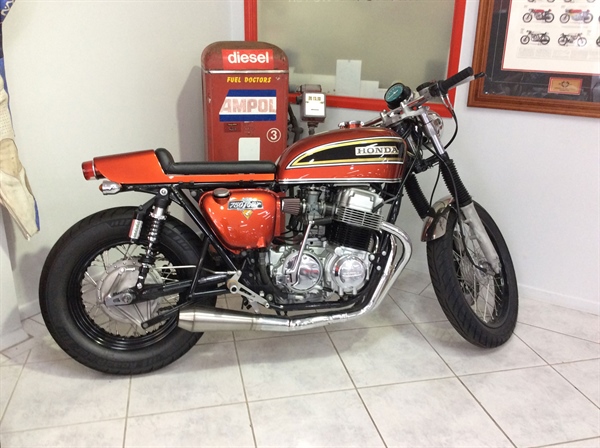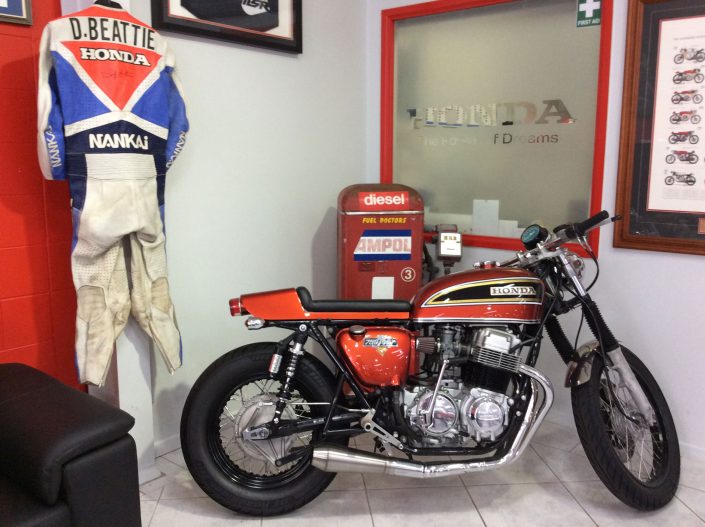1976 Honda CB750 Four
OWNER: Andrew Porta, PUBLISHED: MARCH 2017
HONDA’S ORIGINAL SUPERBIKE
In 1948, a fledgling motorcycle manufacturer called Honda Motor Co., was established in Japan. With just 34 employees, it was a small outfit making small-engine bikes such as the 100cc D-type. Within 25 years, however, it was one of the largest motorcycle manufacturers in the world.
One way it achieved this was by recognising the demands of a given market and catering to those demands with a series of tremendously well-made machines. In the late ‘60s, Honda determined to develop high-performance machines for the public and, recognising that large-displacement sports bikes were popular in developed countries, especially the United States, in 1967 the company began work on what would become one of its most iconic models, the CB750 Four.
Released in 1969, the CB750 was a tremendous success. It was big, powerful, fast and comfortable, utilised innovative technology such as a disc brakes (at the front, at least), and its four-cylinder engine was good for a potent 68hp and a top speed nudging 200km/h. Not surprisingly, the CB750 became known as the first ‘superbike’ and over the years has consistently been judged as one of the finest bikes ever built.
The CB750 on these pages is a 1976 model and has been owned by Andrew Porta for five years. Andrew, dealer principal at Cairns Honda, has worked some modification magic on it but, even with the changes, it remains emphatically a CB750. “I wanted a CB750 because it was the first of the big inline fours and a ‘superbike’,” he says. “I bought it from a guy in NSW and it was in fair condition, rideable and pretty complete – it wasn’t a bad bike at all.”
Taking it to his workshop, Andrew proceeded to put in eight months of work into a project that would make this big bike uniquely his, giving it a café racer style he had always desired. “It is quite heavily modified,” he admits. “I pulled the engine down, put in new pistons, new everything really.
I took it up to an 836, installed stainless steel valves, new chains and seals, re-did the bearings and bought a Tri-Y exhaust system out of the UK. The carbies were re-jetted to suit that new system and I also put a set of Gazi shocks on the rear and heavier springs on the front. “I also put rear-set foot pegs on it and then, as it has a drum brake at the rear, brake rods to suit that rear set. I then installed a set of straight bars and had a friend of mine build up a seat and a rear cowl for it in a café racer style – I love the café racer style and I always wanted one of those.
Finally, the colour was changed from blue with the paintwork done by Bear’s Body Work here in Cairns.” The result of all this work is a CB750 ‘hybrid’ that really catches the eye. And the bike has become, Andrew says, a real talking point amongst customers of his dealership as well as for many who see it out on the street – when he has the chance to ride it.
“I ride it about once a month, not enough really, but that’s mainly because I am so busy,” he says.
“I’m in the dealership six days a week, I have a young family and that just doesn’t leave me much time. But I do love to ride it when I can. I wouldn’t necessarily want to ride it to Brisbane but it is great for a Sunday ride! “And it is a real head-turner and a good talking point for us too,” he adds.
“I keep it in the showroom and it does make people stop and look. However, it’s usually the middle-aged customer who takes notice – people who might have owned, ridden or raced one in the past. The kids pretty much ignore it – to them it’s just an old bike with drum brakes!” That ‘old’ CB750 is not bad work for someone who only moved into the industry four years ago, when he bought Cairns Honda.
Prior to that, Andrew spent 20 years as a cabinet maker. “I grew up on a farm riding bikes and just loved them – loved working on them and mucking around with them,” he says. “And I always wanted a bike shop but my dad told me I was crazy and should get a trade. So, I became a cabinet maker. Then, four years, I sold that business and was able to buy Cairns Honda. And I love my job!”
For Andrew, that job is not only about running a business that sells and services bikes, mowers and power equipment, it is also about gaining his motorcycle mechanic trade qualification . . . It must be said, it is unusual to find a dealer principal who is also an apprentice in his own business.
“I am a third-year apprentice now,” he says with a laugh. “I was working in the shop with my mechanics one day and they said to me that I was mad not to go for the trade. I thought about it and decided to do it. And it is great. It’s exciting working in this business and I just love it! I can’t wait to get to work in the morning and I don’t want to leave work at the end of the day. It’s the perfect job for me . . . in fact, it’s not really a job at all!”
After developing his skills over a lifetime, and polishing them through his apprenticeship, it’s little wonder that Andrew can deliver on a project like the CB750. And it is not alone. Andrew has another bike project on the go – a 1984 Honda VF1000R – but both that bike and the CB750 form only a part of his collection.
In fact, he owns 27 bikes of varying degrees of ‘classic’ status. “It is a bit of an illness,” he jokes of his bike-collecting and restoration habit.
“Of those 27, I might sell a few but there are some that I would never part with. I have a 1978 Honda Elsinore 250, a Maico, a Kawasaki KX420 and another CB750. I also have a 2007 Honda CR250 that I keep in the showroom. That is the last 2-stroke that Honda built. I bought it brand new and it has never even been started. I have had plenty of offers on that one but I would never part with it.”
As for this CB750, well, Andrew says he might part with that one day if the right offer comes along. “I have had a couple of offers around the $13,000 mark and that is pretty close to what I would sell it for. We’ll see.”














